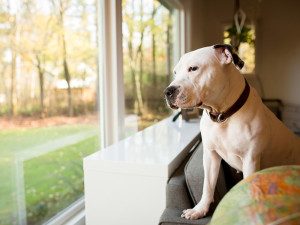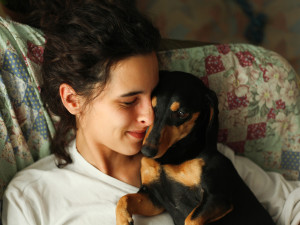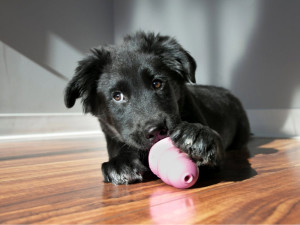6 Ways to Keep Your Dog Entertained While You’re At Work
Don’t hit pause on your pet’s playtime – these solo activities will help 9-5 fly by for them.

share article

Your pet wants you to read our newsletter. (Then give them a treat.)
On the heels of The Great Resignationopens in a new tab is Great Return-to-Work. Unless you can bring your dog to workopens in a new tab with you, have a trusted doggie daycareopens in a new tab, or chose to switch jobs / reduce hours (as Newsweekopens in a new tab reported more than half of millennials have), you may be feeling pretty guilty about leaving your petopens in a new tab at home when you inevitably return to work. You’re not alone.
Truth be told, many dogs do just fine, and simply relax and sleep for a good part of the dayopens in a new tab while we stress out at work. I say “many” because I’m not including dogs who are too young to handle a lot of time alone, or those who are struggling with separation anxietyopens in a new tab or some other condition that makes being at home without you truly traumatic or even just unpleasant. I’m talking about behaviorally healthy dogs who really don’t mind the daily rhythm that includes your regular workday absence (though obviously, they would rather you stayed home).
Along with making sure that their basic needs are met, what else should you provide your dog while you’re gone? Some dogs are fine with a cozy place to snoozeopens in a new tab, and some may be satisfied with a compatible dog buddy or some toys. Others need a little help in finding interesting ways to stay occupied. That’s where activity stations come in. Activity stations are just what they sound like: places for dogs to engage in activities that can be done alone. Setting up different activity stations in distinct areas of your house allows dogs to make good choices and have fun even when they’re on their own.
Activity Station Ideas
This kind of enrichment won’t cure separation anxiety or help a dog overcome a fear of traffic, airplanes, passersby or the sound of sirens, and it’s not a cure for excessive barkingopens in a new tab or destructive chewing. What it can do, however, is make being alone more fun. Here’s how. Deciding what sorts of activity stations will work best for your dog requires you to give some thought to your home’s layout and your dog’s interests and abilities. But basically, they are really only limited by safety concerns and your creativity. Here are some fun ideas:
Tug Toy Station
Some stations are extremely simple, involving nothing more than a tug toyopens in a new tab attached to the wall with a carabiner and a sturdy hook. Dogs who love to tug often do best if the toy is a little stretchy to compensate for the fact that nobody is on the other end giving it life and motion. The toy must be safe — there should be no chance of the dog choking on it, becoming entangled in it, or shredding it. A tug station is not suitable for dogs who would either become obsessive about it or frustrated by it. To interest your dog in a tug toy station, shake the toy a little to make it move before you go to work; once your dog a hold of it, let them tug on their own. Putting peanut butter on the toy makes it more enticing and helps many dogs engage with it more.
Batting Toy Station
A related activity station is for dogs who like to bat at toys rather than tug them. As long as the dog won’t become entangled in the toy or attempt to ingest it, this sort of station can occupy dogs who love to use their paws in play. Toys with multiple hanging parts often appeal to dogs who like to play this way.
Snack Station
Another simple activity station consists of providing your dog with something safe to chew or eat. This doesn’t necessarily mean that you have to buy hundreds of new items. Rotating your dog’s durable favorites, supplemented by an occasional new treat, keeps this activity station from costing a fortune. You can also use stuffable toys, such as Kongsopens in a new tab, or toys that your dog has to chase around or otherwise manipulate for the food to be dispensed — for example, the Wobbling Treatball, Kong Wobbler, West Paw Design's Toppl or Buster Cube.
Make sure you are not giving your dog anything that poses a choking hazard or other dangers. Avoid rawhides and rope toys, and check with your vet about what else may be dangerous for an unsupervised dog. For safety and convenience, create the station away from areas that are off limits to your dog (such as the counter or where your kids store their toys).
Hide-and-Seek Treats
You can also keep your dog occupied by making the whole house (or at least a room or two) a place for food-searching activity. Hide treats while your dog is in another room, say “Find your treats,” and then head out for the day. (If your dog is sure to follow you, tell them to “stay,” or close a gate or door while you hide the treats.)
Teaching your dog to search for food in response to the cue “Find your treats” is not hard, but it’s critical to start by making it easy and gradually working up to greater challenges. Start with the food in full view and point to it or tap your toe by each treat until your dog gets the hang of it. You can also hide treats in dog puzzle toysopens in a new tab that are specifically designed for this purpose.
Toy Basket
This is a great activity station, but for most dogs, it’s only appealing if the contents change frequently. To maintain your dog’s interest, rotate toys in and out and add new ones regularly. That way, your dog will never know which toys will be available on a given day. If your dog has a couple of favorites, make sure they’re always on-hand.
Solo Fetch Station
For dogs who like to fetch, independent play may seem harder to provide. However, some dogs can be taught to fetch on their own using a ball and a ramp or an iFetch. There needs to be enough space for them to chase after the ball without injuring themselves (or your furniture). It takes practice and patience, but once dogs get it, they are able to play on their own.
To teach dogs to use a ramp as a fetching station, start by placing the ball on the ramp and letting it roll away. This accustoms dogs to fetching a ball that has been “thrown” by the ramp. Then, teach them to drop the ball at the top of the ramp themselves. Once dogs realize that they can make the ramp work for them, many really enjoy the activity, though I’ve yet to meet a dog who didn’t prefer fetch played as a social game outdoors. (Caution: this activity station is not suitable for dogs who are so obsessive about fetch that they would play all day and drive themselves mad.)
Again, the safety of the stations and their elements is critical. Don’t use anything that could in any way strangle or trap a dog. Only use toys that can handle serious chewing, the level of which varies from dog to dog. Avoid rawhide or rope toys that a dog can choke on. If in doubt, put the toy away before you leave.
How to Teach Your Dog to Engage With An Activity Station
Don’t expect dogs to automatically be interested in activity stations just because you’ve set them up, however lovingly. The statement “If you build it, they will come” rarely applies. Dogs have to be taught what to do and to understand that the stations have entertainment value before they will engage on their own.
Dogs need specific training for each type of activity station, but some general guidelines apply to all:
Introduce your dog to one new station at a time.
Work step-by-step. Don’t expect your dog to go immediately from expressing some interest to full engagement.
Do what you can to make the station enticing by choosing equipment wisely or applying peanut butter as appropriate — or both.
The bottom line: Activity stations can be antidotes to the boredom dogs may experience when left home alone. Providing them with something constructive to do can improve their quality of life. The stations can also help you fulfill your responsibility to make sure your dog is happy, stimulated and entertained (not to mention, relieve your guilt) when you leave the house. Above all, they’re a wonderful way to change your dogs’ daily alone time from “fine” to “fun.”

Karen B. London, PhD, CAAB, CPDT-KA
Karen B. London, Ph.D., is a Certified Applied Animal Behaviorist and Certified Professional Dog Trainer who specializes in working with dogs with serious behavioral issues, including aggression, and has also trained other animals including cats, birds, snakes, and insects. She writes the animal column for the Arizona Daily Sun and is an Adjunct Professor in the Department of Biological Sciences at Northern Arizona University. She is the author of six books about training and behavior, including her most recent, Treat Everyone Like a Dog: How a Dog Trainer’s World View Can Improve Your Lifeopens in a new tab.
Related articles
![Muscular white pit bull stands on couch, looking out window to sunny fall day.]() opens in a new tab
opens in a new tabSeparation Anxiety in Dogs
Does your dog freak out when you head for the door? Here’s some advice.
![Young woman hugging her small black dog on the couch]() opens in a new tab
opens in a new tabWho Has More Separation Anxiety — You or Your Dog?
It was a trick question. A study shows that the pandemic has made us all codependent.
![Black puppy chews on a frozen Kong treat]() opens in a new tab
opens in a new tabWhy Your Dog Needs a Frozen Kong
Two words: Endless entertainment.
![Siamese cat standing on two feet in order to look out of the window]() opens in a new tab
opens in a new tabHow to Ease Your (Cat’s) Return-to-Office Anxiety
A veterinarian and a behaviorist’s tips for preparing your cat for your new WFO schedule.



